Last week, I went on a bit of a rant about how most of us don’t need to worry about finding our style or finding our voice. You don’t have to pick a lane! Do what you like. Be an omnivore. Follow your bliss.
But sometimes, there’s a good reason to niche down. Here are a few reasons I can think of:
You’re a professional, or you’re trying to get paid for your work. Some people (not everyone) find it helpful to put out one style of work and get known for that. There are loads of good examples of this approach, but I’ll share a particular favorite of mine: Isabella Cotier.
You just want to pick one thing that you do and get to a certain level of competence with that one thing. Plein air landscapes, let’s say, or still life drawings. You feel like you just don’t ever spend enough time on that one thing to get to a skill level that you know would be possible with a bit of practice and study.
You feel like your art (or writing, or quilting, or whatever) doesn’t look like you. It looks like every person you ever took a class from, but it’s not distinctly you, whatever that means.
You think that choosing a project—one thing—would just be an intrinsically satisfying thing to do.
There could be more reasons! If you have other reasons, tell me about it in the comments.
1. Get in touch with your preferences
I’m fascinated by what Nicholas Wilton has to say about preferences. You can watch the video here, but this is what I take from it:
I don’t think we’re born with talent, but I do think we each have certain tendencies, whether those tendencies were with us from birth or whether they emerged over time. Wilton calls them “preferences.” You like this more than that. There’s no reason for it, you just do.
Once you get good at choosing more of what you like and less of what you don’t like—once you learn to lean hard on your preferences—your work starts to look more like you. It gets more specific and particular. And peculiar.
And weirdly, people respond to that. The more narrow and personal and weird your thing is, the more appeal it has. Why? Because it’s not bland and generic. Because it’s not like everything else they’ve ever seen. (or heard, or read, or watched.)
That doesn’t mean it appeals to everyone. Take Phoebe Waller-Bridge’s show Fleabag. It’s so specific and weird and personal! But if you get it, you’re on board. Completely.
Wilton makes it clear that this is not a one-time question. You don’t sit down and make a list of what you like and don’t like, and then you’re done. It’s an ongoing practice—it’s about learning how to say, “I like that, I don’t like this other thing” in both your art and your life. The more you do that, the more your art gets better, and the more your life gets better, and pretty soon you have a very positive feedback loop going.
And your preferences can and will change! Here he is expanding on the idea.
2. Focus on your skills

My dad’s a musician. He played guitar for a living for his entire working life. As you can imagine, watching him practice every day and go to the gig every night had a big impact on me and how I think about doing my work.
A couple months ago he said something so surprising to me: “My advice to budding guitar players today would be to play the guitar you have right now and keep playing it for the rest of your life. Don’t keep buying guitars.”
I said, “Really? Because you were always chasing a sound with new guitars.” It’s true: he was always buying guitars and amps and pedals that he thought would give him the very sound he was going for. That was a recurring theme I grew up with.
“I was chasing somebody else’s sound,” he said. “I should’ve been working on my sound. In order to sound better, you just have to play more.”
This conversation was blowing my mind. “But what if the first guitar is the wrong guitar for you? How do you know you have the right guitar?”
“Oh well you do have the have the right guitar,” he said, contradicting himself a bit, but he’s 79 and allowed to contradict himself. “The point is that nobody ever asked me what kind of guitar I was bringing to the gig. I shouldn’t have been chasing new guitars all that time.”
He quoted some photographer, I forget who, but maybe Richard Avedon or someone like that, saying the same thing about cameras: “No editor has ever asked me what kind of camera I used.”
So here’s what I take from this: Work on your skills. Your voice or style is really the culmination of the skills you’ve acquired—and the skills you haven’t acquired. Your mistakes and shortcomings are as much a part of your voice as your skills.
But get your skills to the level that your work demands, whatever that means for you! Take some classes, find some tutorials. You probably know where the gaps in your knowledge are. Go learn that stuff.
Because once you reach the right level of competence, your work has a kind of ease and comfort that allows your natural style to come through.
There’s a great line in Walk the Line, the biopic about Johnny Cash, where Reese Witherspoon, as June Carter, confronts Johnny, about…well, everything:
You wear black 'cause you can't find anything else to wear? You found your sound 'cause you can't play no better? You just tried to kiss me because "it just happened?" You should try take credit for something every once in a while, John.
I love this line because “I found my sound because I can’t play no better” is just about a perfect description of Johnny Cash’s rough and raw sound. He got his skills to the level he needed to get them to, and then he let ‘er rip.
3. Do a daily project
You knew this was coming, right? A daily drawing (or writing, or singing, or cooking) project will teach you so much!
I love what Chris Piascik says in this video about how daily drawing projects have changed his art and his career. It’s a bit long but worth a watch.
I also love what illustrator Caroline Tomlinson says about doing lots and lots of lots of work:
Happy accidents do occur, however for me at least, it’s often a case of repeatedly drawing the same thing over and over until it starts to feel like my own and there’s some little element of magic. You can’t mimic magic - the hours and hours spent getting there are vast.
Go see an example of what she means by “over and over” right here.
So here are some ideas:
Pick a thing and do it every day for a month. Or as often as you can until you fill a sketchbook. Or every M/W/F. Whatever you can manage.
Plan it out ahead of time. If you’re going to paint 30 landscapes from photos, gather up the photos ahead of time so you don’t waste time choosing one every day. Whatever the project, make it so that you don’t have to spend time deciding anything once you get going.
Put as many constraints on it as you can: I’m going to draw fruit, for no more than ten minutes a day, using only ink. Probably you’ll feel bored and stuck after the first week or two, and if you push through the boredom, you’ll do something interesting and maybe find something that sticks. Set a timer on these projects. Fast and frequent is what you’re after.
Did you finish that project? Was it awesome? Great. Repeat with another thing. Keep going until you’ve done all the things you’re interested in exploring.
See if you can narrow All the Things down to Just a Few Things, then pick one and do a longer project. Maybe a 100 day project. Maybe a self-appointed artist residency.
Rinse and repeat! See where this takes you! See if you get to a place where you find something you want to stick with. Your style—your voice—comes out naturally as a combination of:
The tools you like to use
The subjects you tend to choose
Your best effort, meaning the skills you have worked to acquire
Your preferences
Your wobbliness, weirdness, blind spots, weaknesses, time (or other) constraints, and skills you lack (which will be on display no matter what, and are part of what make you who you are)
4. Learn to recognize your style when you see it

Over time, you’ll start to recognize your style. It’ll be the thing that feels good and familiar but also highly skilled. It’s you at the top of your game, without the pretense. It’s not that photo of you all dressed up at your boss’s wedding. It’s the one of you in your favorite blue jeans, in the back yard, feeling great.
It’s the painting you can’t bear to give away because you like it so much. Or the song you wrote that you sing over and over.
It’s the thing you particularly love for reasons you can’t quite explain, even if it didn’t get the most likes on Instagram.
5. Be willing to outgrow your style and move on
At a certain point, you’ll get tired of that thing and you’ll move on to another thing. Please do!
writes in this post about how her style changed over time. I love to scroll through artists’ Instagram feeds and see how their art changes. When I first started following Anna, I was fascinated by the way she drew crowds of people, like this, and then she started doing this which I love even more. It’s probably going to become something else next. As it should.Are you searching for your style?
I want to hear about it!
Supporters are drawing fall leaves
We’re doing a little artist-in-residence of fall, and I filmed a video in which I used way too many colored pencils, and now I’m going to send this little drawing to one of the supporters of this newsletter.
Would you like to join us? It goes out once a week, we work on many interesting art projects, and you can dive into a whole archive right here. If you can do it in a sketchbook, we’ll get to it eventually!
Here’s a painting you can take home with you!
There are many happy little paintings for sale in my shop, including this 5x7 gouache painting of a bouquet of flowers. It’s gift-giving season! Maybe you’ll find something you like.
A Few Announcements
Are you in Portland? I’ll be at the Portland Book Festival on Saturday, Nov 2.
Order signed copies of my new book, The Tree Collectors, from Broadway Books here in Portland.
Come find me on Instagram, or see paintings for sale- Right here
Order signed copies of some of my books from my husband’s bookstore, or order my books and many books I love at Bookshop.org
Take one of my online writing or art classes here




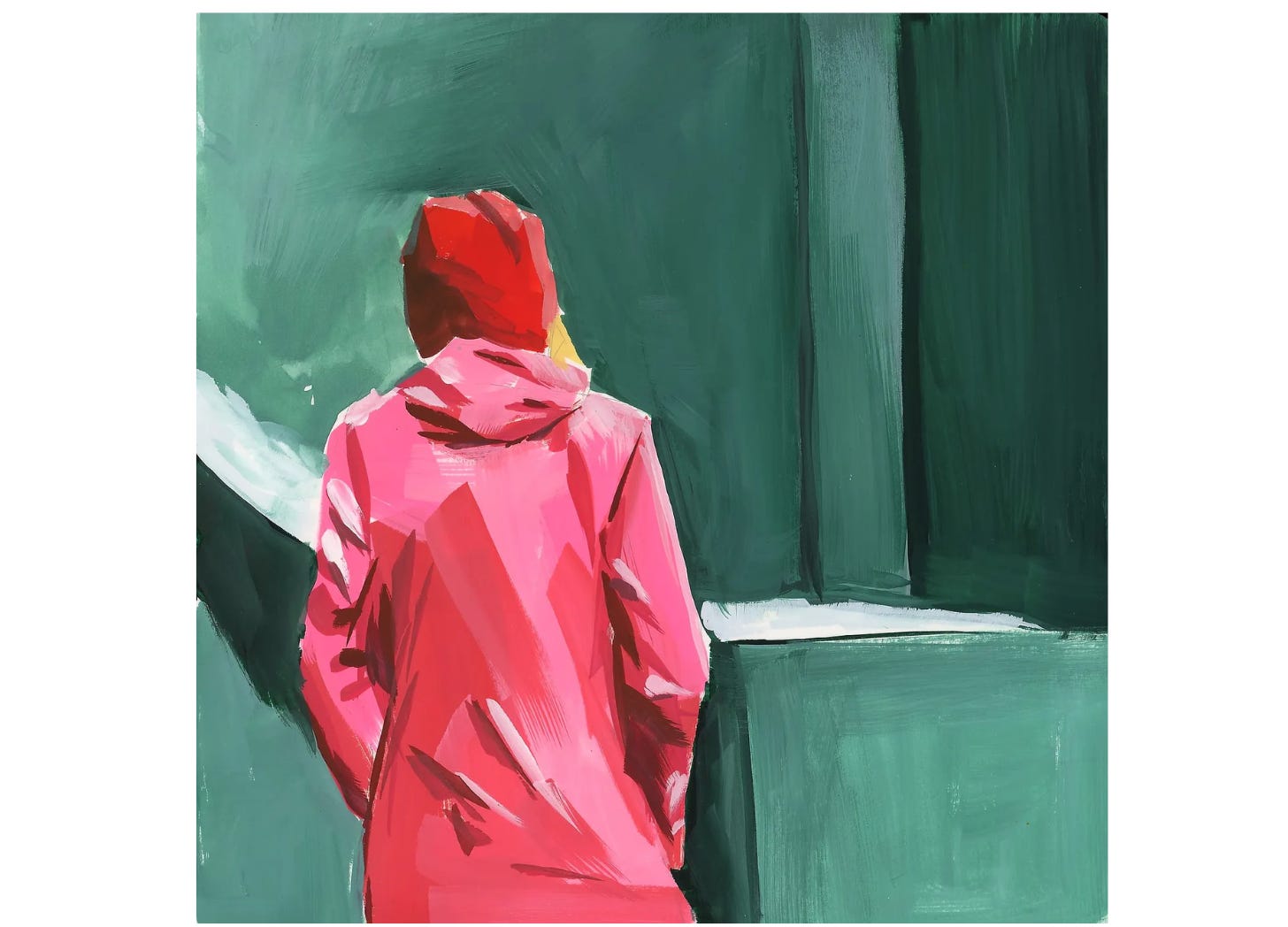
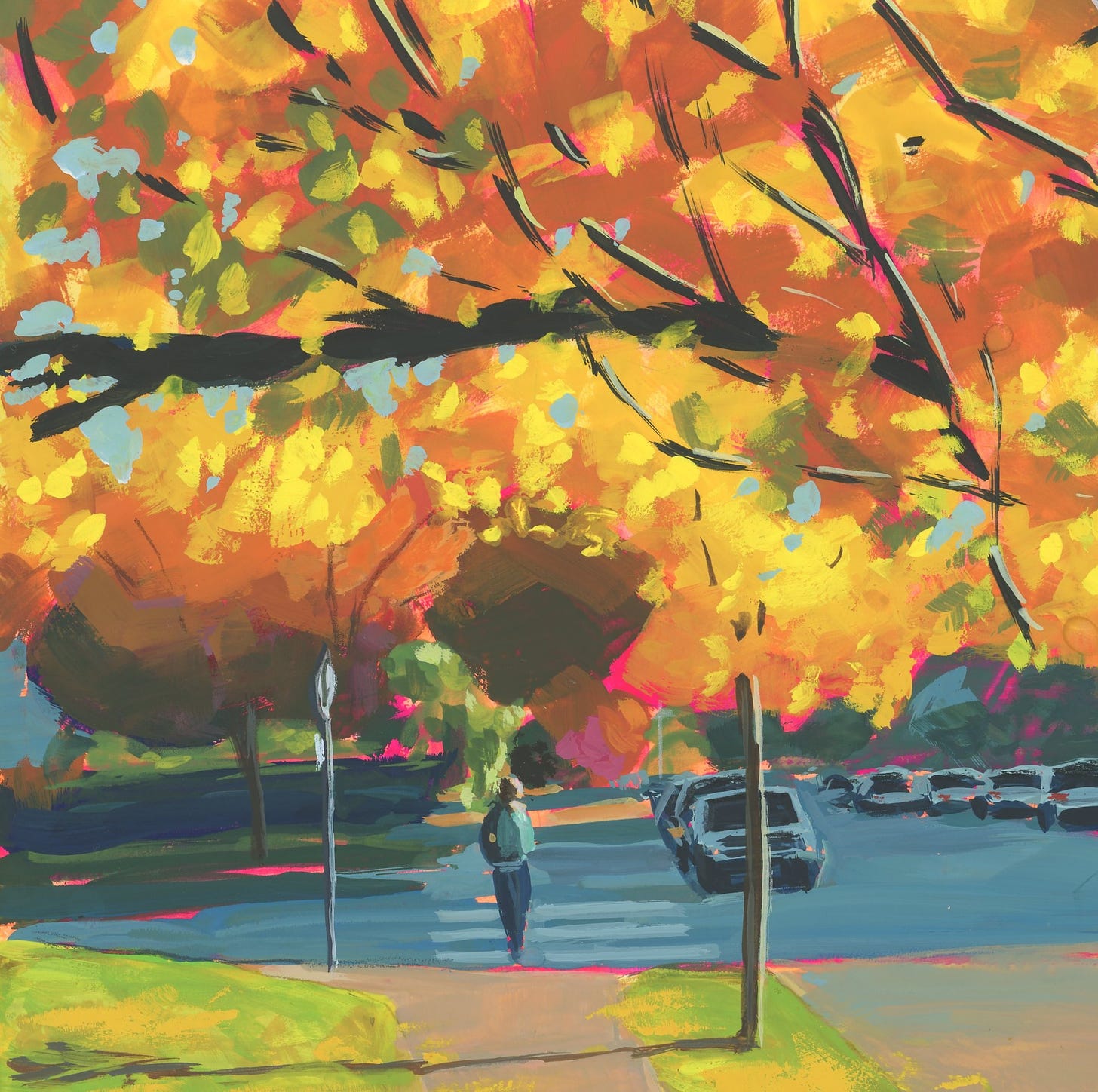
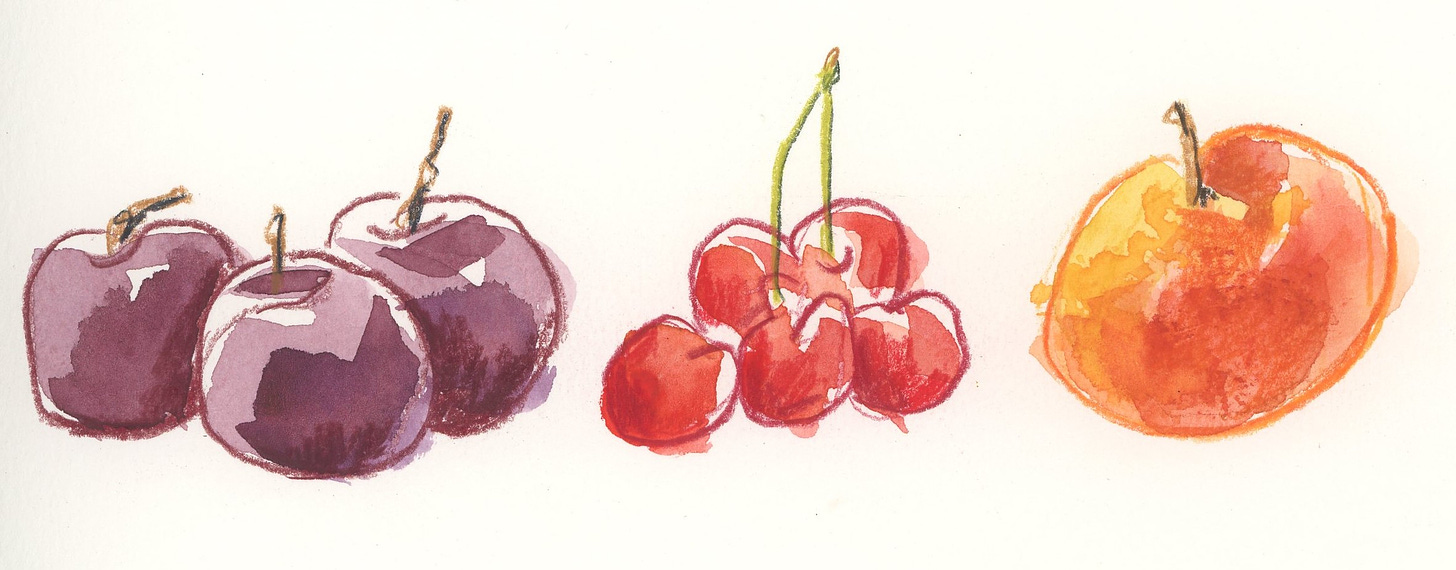
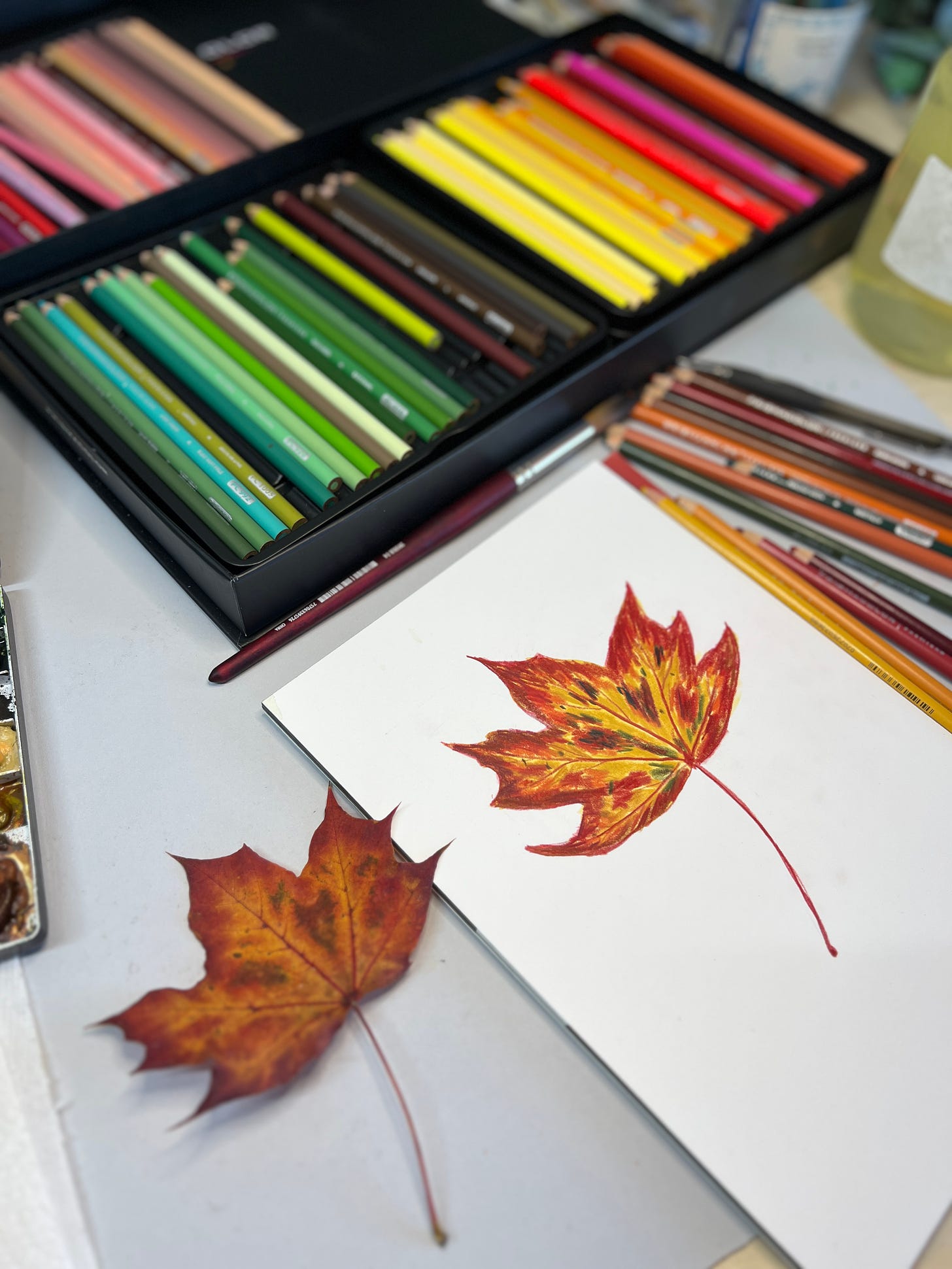
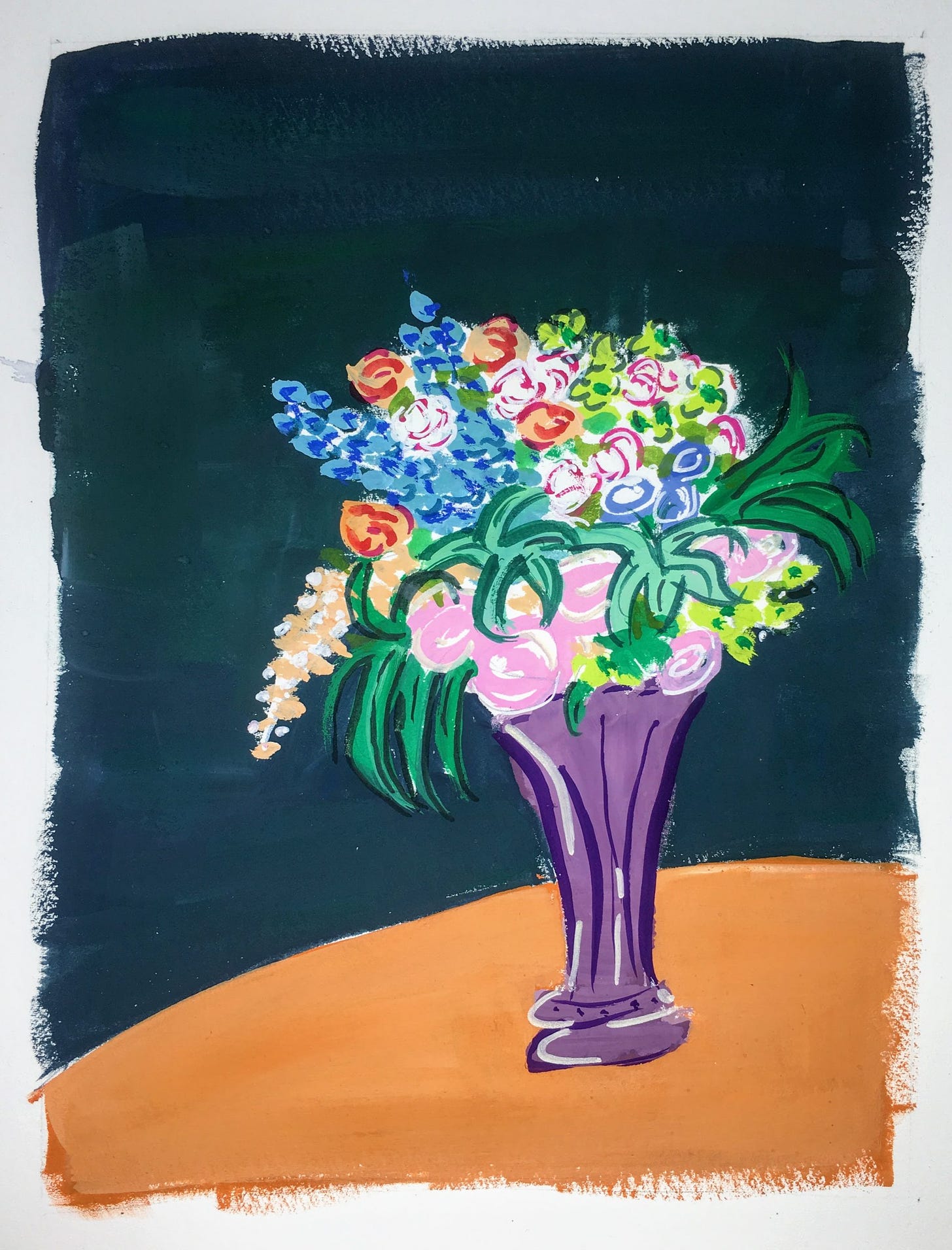
I really enjoy your newsletter. So many ideas you explore. My thoughts on this are that style is not a "thing" to be sought. I have a seriously strong style and have been a professional artist and illustrator all my life, and a long time Santa Fe gallery owner too, so I know a lot about artists and their styles. Style is real and it is important and it does not mean that someone does the same thing intentionally. Artistic style just happens because you make art - lots of it. It is also important to make art that you like and are attracted to. As you try all these things that attract you, some of each is retained until, like with a good recipe, all those ingredients coalesce into your style. My style turned out to be "Disney meets Dali" as art reviewers and others have called it. But I try everything and take every class that intrigues me and my style gets "informed" by all that and changes in subtle ways. But you can always recognize my work. My gallery artists also all had a style that you could recognize, but the same would be true. They were always trying new things, but you could always tell it was them. SO... style is very important to any serious artist, but you don't have to work at finding or making it, you just have to keep making art that interests you, and it will happen all by itself.
When it comes to my sketching style once I found it I knew. I used to sketch very realistic details pics which would take hours of focus. But I had a number of health challenges and then medication for said challenges. Both have resulted in a very short focus. 10 to 15min. 30 at a max.
I discovered an artist called Toby from Tobysketchloose on YouTube. He used a very quick wobbly line. And then I figured out myself that if I used simple hatching with straight lines I could get quite a good result.
I love my new quicker messier style. I actually sketch more often now than I did before. Technically it's perhaps not as impressive but its fun. And I get to keep up a hobby I love even if its in a different way.